SWIMMING SCIENCE BULLETIN
Number 12
Produced, edited, and copyrighted by
Professor Brent S. Rushall, San Diego State University

A SUGGESTED PROGRAM OF FOUNDATIONAL CONDITIONING EXERCISES FOR AGE-GROUP SWIMMERS
[Adapted from Rushall, B. S., Marsden, J., & Young, C. (1993). A suggested program of foundational conditioning exercises for age-group swimmers: A manual for coaches. NSWIMMING Coaching Science Bulletin, 2(1), 1-23. John Marsden is Head Conditioning Coach for the New South Wales Institute of Sport, Olympic Park, Homebush, Australia, and Clive Young is a certified Level 2 swimming coach.]
TABLE OF CONTENTS
- A Suggested Program of Foundational Conditioning
- Exercises for Age-group Swimmers
- Basic assumptions
- Implementing conditioning programs
- Primary Conditioning Levels
- Level 1
- Level 2
- Level 3
- Warning
- Warm-up Running
- A Continuous Weighted Bag/Medicine Ball Program
- Purpose
- Conduct
- Weighted bag/medicine ball exercises
- Training for weighted bag/medicine ball work
- Static Training Exercises
- Training for static exercises
- General Conditioning Exercises
- Exercises
- Training for general conditioning exercises
- Time Allocation
A SUGGESTED PROGRAM OF FOUNDATIONAL CONDITIONING EXERCISES FOR AGE-GROUP SWIMMERS
It is advantageous for aspiring swimmers who are children and young adolescents (age-groupers) to participate in auxiliary training programs with the aim of developing power and strength. The decline in opportunities in modern day living to stimulate overall development in these physical capacities has made such training necessary. This paper describes a program of exercises that is suitable for athletes in their growth years.
Basic Assumptions
The design of this program is influenced by several principles of growth and development. It is believed that these principles should be adhered to because they are in the best interests of age-group swimmers. The design assumptions are listed below.
- Age-groupers are not miniature adults. Age-group swimmers are structurally and physiologically different to adults. Consequently, beneficial training activities are likely to be different to those employed for adults even though the aims of such activities might be similar.
- Age-group swimmers are better served by general programs of development than specialized programs. The question of whether age-groupers should specialize in particular sports at an early age has been asked for many years. The evidence now seems to support programming activities that develop overall capacities rather than specialized functions while young athletes grow. Consequently, even though a young athlete may be training for one sport, any auxiliary training should promote balanced overall growth stimulation. Some of that stimulation will be appropriate for the sport in question.
- Age-group swimmers are better served by auxiliary training activities that do not employ localized restrictive apparatus. If resistance training is to be done with children and young adolescents, exercises should involve submaximal loads, such as one's own body weight, light dumbbells, weighted bags and/or medicine balls. Sophisticated and restrictive weight exercises, particularly on machines, are note ideal for children. General whole-body activities are more important and beneficial for young swimmers than the exercises used for adult or mature athletes.
- Flexibility and strength/power development should be developed concurrently in age-group athletes. As young people mature, it is important to maintain a high degree of flexibility while increasing strength and power. Such an emphasis will maintain the athlete's capacity to employ improved capacities through the full range of movement potential.
- Auxiliary training should occur after the sport training session so that any fatigue will not interfere with the potential for skill development. All sports, and swimming in particular, require a high degree of skill for superior performance. The major emphasis of an age-group swimming program should be skill excellence. For skills to be developed, learning should occur in non-fatigued states. If exhaustive auxiliary training was to occur prior to a swimming practice, fatigue would reduce the learning potential of the swimming session. Thus, it is advisable to schedule auxiliary training sessions either after a swimming session or at some time that allows complete recovery from its execution so that no residual fatigue is carried into the swimming practice. If fatiguing auxiliary training occurs prior to a practice, it is advisable to have the following pool training session emphasize energy training rather than intense skill development.
When performing the routines contained in this booklet, coaches and swimmers should avoid stressing working each exercise and the programs to fatigue failure. The programs are designed to produce body coordination, functional strength, and explosiveness. Those capacities are compromised when an athlete works in high states of fatigue because the development of these qualities, like skills, are neurally based, not energy driven.
- Progress rates in strength and power will be particularly individual in age-group athletes. The development of physical capacities is governed by the stage of maturation of the individual. Since growth rates of children and young adolescents vary considerably, it is only appropriate to judge improvements within the athlete. It is inappropriate to compare athletes. Thus, no child should be made to feel that he/she has to improve as much as another when participating in auxiliary training activities.
- The types and amounts of auxiliary activity improvements will be governed by the stage of maturation of the individual. The developmental stages of growing children and adolescents dictate the physical capacities that can be improved. There are particular times when forms of activity are initiated so that they will coincide with the growth potential of each individual. This phenomenon further complicates social comparisons between athletes. When some individuals improve rapidly on some exercises, others may not be "ready" to progress in a similar manner because their "biological clocks" have not been turned on.
- It is better to do too little than too much auxiliary training. If a programming error was to be made it would be best to schedule few auxiliary training sessions than too many. It has been shown that when developed slowly strength, power, and flexibility achieve higher levels and are retained longer in periods of detraining than programs that attempt quick development. It may be beneficial to limit the number of auxiliary training sessions to two or three per week. Excessive auxiliary training may reduce participant motivation and may not facilitate improvement in an optimal manner.
- There is an optimal level of strength and power that is appropriate for swimming. Excessive capacities in these factors do not enhance swimming capabilities. Thus, training needs to develop capacities to a certain level. A preoccupation with auxiliary training would usually be to the detriment of the age-group athlete.
- Auxiliary training activities should either be explosive or static. The many hours of long distance swimming which is a necessary part of training has a tendency to stifle quick and powerful movements. Auxiliary training programs can be used to counteract this suppression. Activities should be either explosive and powerful, as in sprint swimming, or static, as in holding postures and stabilizing movement bases.
Implementing Conditioning Programs
The standard of program expectations contained in this booklet is quite high. For many new age-group swimmers their muscular condition and capacities may not be sufficient to engage in the prescribed activities. Consequently, it is necessary to evaluate the status of each swimmer before embarking on these conditioning programs. There are three levels of preliminary fitness testing that are recommended. It is only after all the activities of the third level are performed satisfactorily that a swimmer should be allowed to participate in this foundational conditioning program.
Each age-group swimmer should be tested prior to entering the foundational conditioning program. Those that cannot demonstrate the requirements for Primary Fitness Level 3 (see next section) should continue with the exercises in the level that was failed until the next assessment session. It is suggested that testing sessions for primary fitness levels be conducted every four weeks. Swimmers should not proceed to the next level until they can complete all exercises in a given level. This structure will provide swimmers with a controlled progression of development. This may produce some organizational difficulties for coaches who have squads of swimmers with different standards of ability but has to be entertained for safety purposes.
Testing protocols are described in the Section 1.
Section 1
PRIMARY CONDITIONING LEVELS
There are three levels of testing to determine the initial fitness condition of age-group swimmers. The tests and training programs involved in each level are described below.
Each testing or training session should be preceded by a full metabolic and flexibility warm-up.
Level 1
Three sets of each exercise are to be completed in a well-controlled manner with adequate rest being provided between each set.
- Push-ups on knees. Complete 10.

- Isometric squats to a knee angle of 90 degrees using both legs. Perform 10 with each being held for 15 seconds.

- Bench dips to where elbows are level with the shoulders and the knees bent at an angle of 90 degrees. Complete 10.

- Sit-ups with knees bent 90 degrees (arms at the sides, hands on the ground). Complete 5 with control.

- Weighted bag/medicine ball chest pass, catching and passing with accuracy. Complete 10.

- Knees to chest on the ground. Complete 10.

- Jump squats to full extension with hands touching ground with each crouch. Complete 10 in a rhythmical manner.
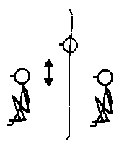
- Partner pull-ups with legs straight. Complete 5 with control.
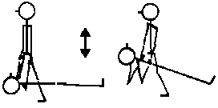
- Abdominal lowering to the count of 5. Complete 10.

- Alternate leg lunges. Complete 5 on each leg.
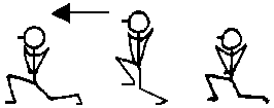
Level 2
Three sets of each exercise are to be completed in a well-controlled manner with adequate rest being provided between each set.
- Push-ups with straight body and weight on hands and feet. Complete 5.

- Isometric squats to a knee angle of 90 degrees using one leg. Perform 5 on each leg each being held for 15 seconds.

- Bench dips to a depth where elbows are level with the shoulders and legs are held straight. Complete 5.
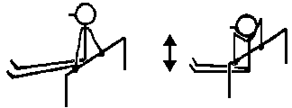
- Sit-ups with knees bent 90 degrees (rise to a vertical position; arms straight, hands resting on the ground). Complete 10 with control.

- Weighted bag/medicine ball catch and pass both hands alternately from each side (rugby pass). Complete 10 from each side.

- Knees to chest off a bench. Complete 10 with control.
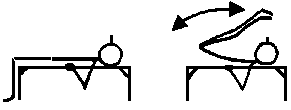
- Jump squats to full extension, hands touching ground with each crouch, land in a 0.5 meter square. Complete 10 in a rhythmical manner.
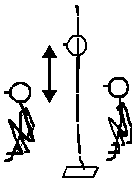
- Partner pull-ups with legs straight. Complete 10 with control.
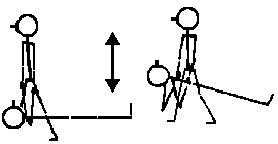
- Twist sit-ups. Alternating with each trial, complete 10 to each side.

- Alternate leg lunges. Complete 10 on each leg.
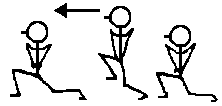
Level 3
Three sets of each exercise are to be completed in a well-controlled manner with adequate rest being provided between each set.
- Push-ups with straight body and weight on hands and feet. Complete 10.

- Isometric squats to a knee angle of 90 degrees using one leg. Perform 10 on each leg, each being held for 15 seconds.

- Bench dips to where elbows are level with the shoulders and the legs are held straight. Complete 10.

- Sit-ups with knees bent 90 degrees (rise up to a vertical position; arms straight with hands resting on the ground). Complete 20 with control (no bouncing).

- Weighted bag/medicine ball overhead catch and pass with both hands. Complete 10 in a rhythmical manner.
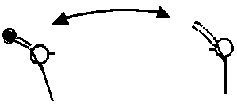
- Knees to chest off a bench (return legs to full extension but do not rest the feet on the ground). Complete 20.

- Jump squats to full extension, hands touching ground with each crouch, land in a 0.5 meter square. Complete 10 in a rhythmical manner.

- Chin-up with hands double shoulder width apart. Complete 1.

- Twist sit-ups. Alternating with each trial, complete 20 to each side.

- Walking spring lunges. Complete 10 on each leg.
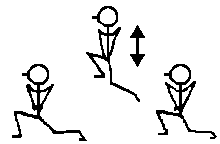
WARNING
Only when the exercises in Level 3 are performed satisfactorily should a swimmer be able to enter the foundational conditioning program described in the following sections.
Section 2
WARM-UP RUNNING
The full training session should commence with a run for at least 10 minutes. The degree of effort of the run should be sufficient to produce a moderately high heart rate (usually somewhere between 150 and 170 beats per minute for most athletes). Athletes should be encouraged to cover a greater distance on each successive training session. This activity will raise the core temperature of the athlete to facilitate the performance of the ensuing activities.
Athletes should be partially "warmed" prior to the run.
Section 3
A CONTINUOUS WEIGHTED BAG/MEDICINE BALL PROGRAM
Purpose
The purpose of this program is to provide a series of activities that are performed in a continuous manner and use rhythmical total-body movements to overcome moderate resistance.
Conduct
- For safety reasons it is recommended that weighted bags be used for this activity rather than medicine balls. Bags have several advantages: (a) they do not roll when dropped, (b) if caught improperly they rarely injure, and (c) if they hit a performer the trauma usually is negligible. How to obtain weighted bags is indicated at the end of this document.
- Instruction should stress guarding against injury and performing the activities in a rhythmical consistent manner. Presenting the bag/ball to the partner in a desirable manner and position is critical to the success of this activity.
- The conduct of these activities is dependent upon complete cooperation between athletes as they function in their paired activities. Cooperation will be facilitated if the pairings comprise athletes of similar abilities in this category of exercises.
- Activities are performed in SEQUENCE IN A CONTINUOUS MANNER. Because there is considerable partner activity, there are intermittent short rests while the resistance object is passed from one partner to the other.
- The resistance to be used should be one that is "suitable," that is, it can be handled by the athletes, so that the skilled activities can be performed well and with effort. The type of resistance should be a weighted soft bag or a medicine ball. It is advised that bags/balls be of 3, 4.5, and 6 kilogram sizes.
- The activities are skills which require catching and throwing from a variety of positions and in several manners. Early participation should be devoted to developing the skills of catching and throwing in the prescribed exercises so that there will be no threat of injury or accident. At all times the skill of executing the throws and catches and the delivery of the object to the most accommodating position for the partner should be emphasized.
- Overload is developed by increasing the number of repetitions of each exercise, the number of "circuits" of the exercises, and/or increasing the weight of the object thrown. It is desirable to work with a heavy object so that strength and power will be the main physical capacities developed. The resistance of the activities should be such that obvious "effort" is always required of participants.
- No athlete that has an injury for history of back problems should be involved in this section of the program.
Weighted Bag/Medicine Ball Exercises
Sequence 1. Only partner activities are described. This limitation is deliberate because the program is intended to be performed by groups of athletes. The set of exercises is repeated in three postures: (a) standing, (b) with full leg and hip flexion and extension, and (c) kneeling with ankles plantar flexed and the knees and hips flexing and extending as much as possible during each action. All exercises should fully involve the total anatomy of the individual.
All throws should attempt to develop explosive movements.
All catches should be smooth and incorporated into the preparation of the next throw without halt of interruption in "flow."
Standing Exercises
- Two-hand toss overhead from behind the head.
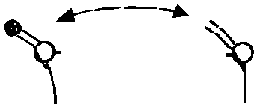
- Alternating left hand and right hand toss and two-hand catch.

- Two-hand push pass from in front of the chest.

- Underarm two-hand toss from between the legs. [This may not be possible when kneeling on the ground.]
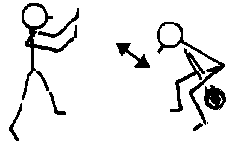
- Backward two-hand overhead toss.

- Alternating left and right twisting side toss.

Squatting Exercises
The above exercises should be repeated while executing a squat on catching the object and leg/hip extension on throwing. Initially the degree of squat should be half of the full range of movement. As adaptation occurs to the exercise, the squat can be increased to a full range of movement.
- Two-hand toss overhead from behind the head.

- Alternating left hand and right hand toss and two-hand catch.
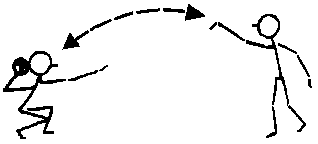
- Two-hand push pass from in front of the chest.

- Underarm two-hand toss from between the legs.
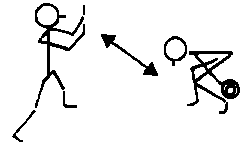
- Backward two-hand overhead toss.
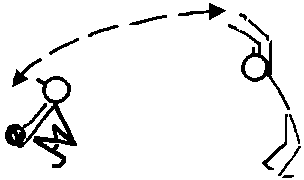
- Alternating left and right twisting side toss.
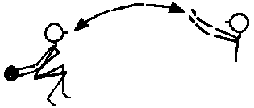
Kneeling Exercises
The above exercises (except 1.4) should be repeated in a kneeling position with a sitting action being included in the catching action and a rising action being incorporated into the throwing action.
WARNING. No swimmers with knee problems should be involved with the kneeling exercises described in this section.
- Two-hand toss overhead from behind the head.

- Alternating left hand and right hand toss and two-hand catch.

- Two-hand push pass from in front of the chest.
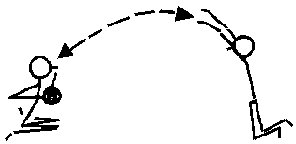
- Backward two-hand overhead toss.
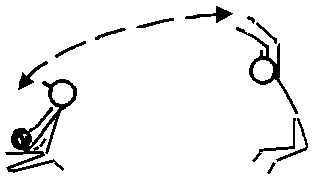
- Alternating left and right twisting side toss.
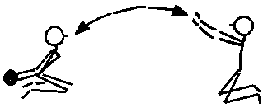
Sequence 2. Only when Sequence 1 exercises can be performed easily and consistently should this sequence be attempted. It is an extremely difficult activity and may be demanding for younger swimmers. Swimmers who cannot perform these exercises should persist with Sequence 1.
This series of exercises should be conducted while seated on the ground balanced with knees bent and feet raised.
- Two-hand push pass and catch.

- Two-hand overhead pass and catch.
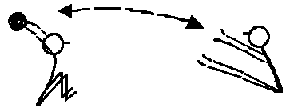
- Alternating left hand and right hand toss and two-hand catch.

- Two-hand catch, lie down to full extended position holding the ball off the ground and sit-up in time with the throw to raise the legs off the ground.

Training for Weighted Bag/Medicine Ball Work
- After passing Primary Conditioning Level 3 of the initial screening exercises, the first priority is to develop the skills for doing the exercises.
- When exercises are first used for training, that is, the skill learning stage has finished, brief rests between exercises should be programmed.
- As training sessions increase, the length of rests should gradually diminish until the whole routine is completed without interruption.
- Once Sequence 1 is performed easily and consistently, Sequence 2 should be introduced.
- Overload increases can then be achieved by: (a) extending the period of time for each exercise, (b) progressing to heavier objects, (c) attempting to toss the object over increased distances as a means of increasing the explosive quality of the activity [safety factors should always be considered], and (d) increasing the speed of execution of the catches and tosses.
- The maintenance in exercise quality is paramount. The athletes' conduct should match the discipline that is expected in the pool.
- Each throw should stress an explosive movement.
WEIGHTED BAGS:
WHAT THEY ARE AND HOW TO GET THEM
The primary author of this article recommends that swimmers use weighted bags rather than medicine balls for the prescribed exercises. Weighted bags have several advantages over medicine balls.
- They do not roll if dropped.
- If they should hit a swimmer their impact is spread over a wide area and usually does not result in any pain or injury. That contrasts to a medicine ball which has a very small point of contact.
- Weighted bags require particular use of the fingers for catching and adjusting the object. They have a greater potential for increasing total arm and hand strength.
- They are easily stored by stacking in a box. Their volume is less than medicine balls and so they require less storage space.
- Weighted bags are constructed of the same material as sailing bags and so are more resistant to moisture. The leather of medicine balls is quite reactive to moisture and often goes our of shape very quickly as well as being susceptible to rot.
- The COST of weighted bags is approximately 20% that of medicine balls.
The bags used in the development of the program described in this Swimming Science Bulletin were designed by Clive Young, Dr. Brent Rushall, and the coaches of the Forbes and Ursula Carlile Swimming Organisation. They are constructed by:
BOB BREWER
SAILMAKER
39 SYDENHAM ROAD
BROOKVALE
NSW 2100
(Telephone: 02-9905-4103)
The bags currently come in sizes of 3, 4.5, and 6 kilograms. These are sufficient weights for a squad of varying swimmer levels. While experimenting with the swimmers in the Carlile Organisation, there has been no need to purchase bags of greater weight.
If any reader has inquiries about these bags, it is suggested that Bob Brewer be contacted for information.
Section 4
STATIC TRAINING EXERCISES
Some muscle groups are better trained for swimming by doing static (isometric) exercises. The exercises described in this section are associated with tests of muscular condition that are prescribed for swimmers.
- Front Abdominal Hold. The athlete is required to hold a particular position until the position is altered significantly or a prescribed time period elapses.
The athlete should lie on a comfortable, flat surface.
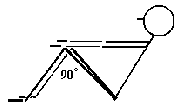
- The legs should be drawn up so that the feet remain flat on the ground and the knee bend is 90 degrees (the edge of a book can be used to measure the correct angle).
- The athlete extends both arms forward, straight, fingers stretched, and palms facing downward.
- The straight body is raised until the wrists of both arms are over each corresponding knee. This is the "start" position.
- The exercise is performed improperly when any of the following occur.
- The arms are not held straight, fingers stretched, palms down, and positioned over the knees. A change in any of these characteristics is significant. It is important to keep the arms in this position because most swimming actions require specific arm positioning while the body is stabilized.
- The back is not held straight. If it starts to bend or "give" the position changes outside the bounds of the activity.
- Any other alteration that changes the position.
- Lumbar Hold. The athlete is required to hold a particular position until the position is altered significantly or the prescribed time period elapses.
The athlete should lie, face down, on a comfortable, flat surface.

- The legs should be extended fully, knees straight, and toes pointed; in much the same position as is desirable for maximum streamlining when swimming. The feet should be together.
- Both arms should be extended forward and straight with fingers stretched, and palms down.
- The face should look directly downward with the nose touching the ground.
- Both legs should be raised with the straight streamlined leg position being maintained. The knees should be held well clear of the ground with at least the mid-point of the thigh being off the surface. This is the "start" position.
- The exercise is performed improperly when any of the following occur.
- The knees bend or the pointed foot position is altered.
- The arms are not held straight. If they start to bend or "give" the position of hold changes which is outside the bounds of the exercise.
- The mid-position of either thigh or any other part of a leg touches the ground.
- Any other alteration that changes the position.
- Horizontal Arm Hold. The athlete is required to hold a particular position, while supporting a weight, until the position is altered significantly, or a prescribed time period elapses. The position of the forearm, wrist, and hand in a pulling pattern is particularly important for establishing force application. The alignment of those anatomical segments must be straight. The ability to maintain that integration will greatly affect the propelling efficiency of a swimmer. This exercise trains that capability.
The athlete should sit on a normal sturdy chair, lean forward and support the back of the upper arms on the knees, and hold both arms and hands horizontally in a straight line. A weight should be supported in each hand.
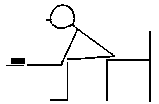
- A normal sturdy chair should be used for the exercise. The lower legs should be vertical with the knees being hip-width apart.
- The athlete should lean forward so that the lower back of the upper arms rest on the knees. The elbows should be in front of the knees and not supported. The angle of the upper arms and contact with the knees will produce a stabilizing effect on the swimmer's posture for the exercise.
- Both arms should be extended parallel to the ground with the hands face-up. The alignment of the lower arms, wrists, and hands should be straight.
- A weight should be supported at the base of the fingers of each hand. Each hand weight should be five percent of the body weight. Table 1 indicates the single hand weight to be used.
- When the body position and the straight arms are held with the weight across the base of the fingers, the "start" position has been attained.
- The exercise is performed improperly when any of the following significant position changes occur.
- The arms are shifted from their relational position to the knees.
- The arms are not held straight. If they start to bend at the wrist, the fingers "curl" around the weight, or the horizontal attitude starts to sag downward, the ability to hold the important alignment has ceased to be demonstrated. Exercise cessation occurs even if changes occur in only one arm (a weakness in that arm is demonstrated).
- Any other alteration that changes the position.
TABLE 1. THE WEIGHT TO BE SUPPORTED IN EACH HAND FOR THE HORIZONTAL ARM HOLD EXERCISE.
=========================================================================
Body Weight Exercise Weight Body Weight Exercise Weight
40 Kg 2.0 Kg 80 Kg 4.0 Kg
50 Kg 2.5 Kg 90 Kg 4.5 Kg
60 Kg 3.0 Kg 100 Kg 5.0 Kg
70 Kg 3.5 Kg
=========================================================================
Training for Static Exercises
- After passing Primary Conditioning Level 3, the first priority is to develop the skills for doing the exercises.
- When exercises are first used for training brief rests between exercises should be programmed.
- As training sessions increase, the length of rests should gradually diminish until each exercise can be performed continuously for four minutes.
- Overload increases can be achieved by: (a) extending the period of time for each exercise, and (b) decreasing the rest intervals between each repetition. It is recommended that the amount of contraction time for each exercise in each session be four minutes.
- The maintenance in exercise quality is paramount. The athletes' conduct should match the discipline that is expected in the pool.
Section 5
GENERAL CONDITIONING EXERCISES
This series of exercises is designed to employ explosive or high effort movements in the general muscle areas that are important for swimming. Because of the severity of these exercises and their emphasis on arm and shoulder work, the coach may want to intersperse them throughout the total conditioning session so that adequate recovery can occur.
Exercises
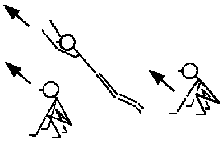
- Jumping with full squat (hands to ground). Complete four sets of 10 repetitions. The bounds should be continuous, flowing from one into the other, and should stress explosiveness off the ground.

- Wheel barrow. In pairs, total weight should be taken on the arms of the person being "wheeled." The supporting partner holds the ankles of the person on the ground at a height that is higher than the wheeled partner's hips. Complete four repetitions of 20 meters, changing partner roles between each repetition.
- Wide-chins or eccentric wide-chin drops. The athlete should hang from an overhead bar with the hands spread at a standardized width.
- To determine the hand-width distance, stand the athlete back to a wall with arms spread parallel to the ground. Measure the distance from elbow to elbow.
- The elbow-to-elbow distance is marked on an overhead bar at a height that requires the athlete to jump to grasp it.
- The bar is gripped overhand with the second finger of each hand over the appropriate mark.
- The athlete hangs from the bar. The feet should not touch the floor.
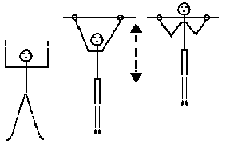
The activity is performed in the following fashion.
- The athlete pulls up to the bar so that the chin clears the bar.
- The athlete must lower to a full relaxed hanging position after "chinning" the bar and before attempting the next trial.
- The raises and dips must be done in a rhythmical fashion.
- The focus of the movement to raise the body should come from contracting the large muscles in the upper back and front of the body. It should not be done with the arms. By mobilizing those large muscles, an action which needs to be done in swimming, the athlete will better distribute the work load of the exercise across appropriate muscles.
- The activity ends when interruptions to the consistent correct performance of the exercise occur. Significant interruptions are as follows.
- The lowering action does not go all the way to allow the arms to straighten.
- The chin does not clear the bar. "Almost there" attempts are not counted and are reasons to stop the exercise.
- There is a rest/stop at the lowered position. Brief rests, which do not occur in swimming races, allow some recovery and, therefore, do not reflect the desirable capacity that is being measured.
- Grip changes are not permitted.
Swimmers should be able to perform the chinning action for that is one of the activities contained in Primary Conditioning Level 3. When swimmers are unable to complete several chins, they should embark on a concerted strength training program aimed at developing strength and technique of adducted movements. The action involved in this exercise is very important in modern swimming techniques and it needs to be developed to the point that it can at least be measured by this exercise and then improved through further training.
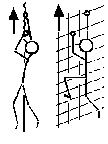
- Rope climbs or climbing. This is a variable exercise that is determined by the availability of facilities and equipment. It is mainly one of encouraging the performance of arm-shoulder supported activities requiring very high levels of effort. Climbing ropes without using the feet is desirable, however, some females may need to use their feet to achieve some distance achievement. The distance climbed is the criterion for improvement.
The use of cargo nets and wall bars can be substituted. Performance on those apparatuses should be to some criterion determined by the coach.

- Walking on hands. This gymnastic stunt may be able to be performed by a few swimmers but will generally be a partner activity. One partner is the walker while the other supports that individual. The supporter holds the walker's ankles so that the walker is in a completely inverted position. Hand movements are alternated. The walker should complete three sets of hand movements, gradually increasing the number of "steps" as he/she gets stronger and more skilled. The walker and supporter should change places between each repetition.
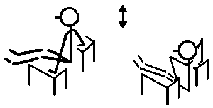
- Wide dips. The athlete should be placed between two sturdy chairs so that he/she can dip down and raise up between them. Legs should be straight with only the heels of the ground. The upward movement should be as explosive as possible with the intent of trying to get the hands to leave the chairs. Care should be taken to ensure that the chairs do not move. If they do they constitute a safety hazard.

- Sprint running. Athletes should perform maximum explosive sprints over 25 meters. The number completed will depend upon time and between runs recovery. The activity should cease when the degree of explosiveness decreases.
Training for General Conditioning Exercises
The major factor to be considered when employing general conditioning exercises is that they be conducted with good form and an emphasis on explosiveness. An obvious method for increasing the overload value of these activities is to increase their number of repetitions. However, that should only occur if there is no compromise in the quality of the activity or the explosiveness. Another alternative for increasing the loading factor is to further extend the effort level of each athlete's approach to each exercise. If that is followed, there is likely to be little increase in the quantity of repetitions for each exercise. That is a desirable outcome.
Section 6
TIME ALLOCATION
The amount of time available to perform these foundational conditioning activities for swimmers will depend upon pool times and the feasibility of swimmers' attendance. It is projected that the activities would take approximately 90 minutes with adequate rest/recovery is included.
As a time saving strategy, swimmers should be advised to be partly or fully warmed-up before the run. If the run is the first activity it will ensure a full warm-up for the remaining activities.
It is proposed that the activity types be performed in the order in which they are presented in this manual.
- Preliminary activities prior to the session start.
- Running for 10 minutes.
- Medicine ball work for 20 minutes.
- Static exercises for 15 minutes.
- General conditioning exercises for 30 minutes.
- Jog for 10 minutes to warm down.
Exercise sessions should be performed no more than three times per week and more preferably twice per week. In periods of strength maintenance, once per week would be sufficient.
Overload
The exercises should be overloaded in progressive steps. Once an exercise becomes comfortable it should be increased in difficulty, load, or time requirement. Complacent auxiliary training of this nature will have no beneficial effect for athletes. The program must always remain challenging for improvement.
Effort Levels
All activities should be explosive and powerful. However, they should not be extremely exhausting. The weighted bags/medicine balls and static exercises may produce fatigue but not to the extent that the conduct of exercises later in the program will be compromised. If a coaching error was to be made, less volume would be better than too much.
All exercises should be performed with the highest standard of form and technical competence. Correct execution should not be sacrificed for harder levels of effort.
This program should persist well into the teen years of swimmers, emphasized in basic phases of training and maintained in periods of specific training. Specific strength exercise might be considered when the program becomes "easy" for the athletes.
Return to Table of Contents for Swimming Science Bulletin.









































































